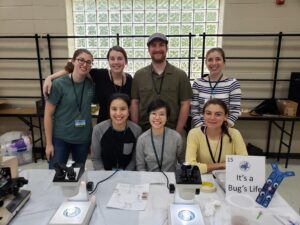Researchers aim to define host-parasite interactions by modeling the effects of coinfection on community dynamics
By Andy Flick, Evolutionary Studies Initiative scientific coordinator

Research conducted at Vanderbilt has been published in a new study in The American Naturalist that models how parasites interact to affect their host’s behavior. The results of the research, conducted by Faith Rovenolt, BA’20, and Ann Tate, assistant professor of biological sciences, reinforce an understanding of the influence of disease in community dynamics.
The pair created a new model to study coinfection of hosts and developed a table of known interactions between parasites infecting the same hosts.
“I wanted to create a model that involved resistance and tolerance to parasites, since they should have different impacts on host ecology and evolution,” said Rovenolt, now a graduate student at the University of Pittsburgh. “We already had some experimental data suggesting that our hosts, two flour beetles (Tribolium), fared differently under infection, so it made sense to incorporate it all under the same framework.”
| Host | Outcome | Parasite | Mechanism | System |
|---|---|---|---|---|
| Mortality | Down | Competition | Cross Immunity | Trypanosoma brucei strains in mice |
| Mortality | Up | Competition | Resource Competition | NPVs and entomopoxvirus in the tea tortix Adoxophyes honmai |
| Mortality | Up | Facilitation | Tissue Damage | Legionella pneumophila and influenza virus in mice |
| Recovery | Up | Competition | Space or resource competition | Helminth and Giardia in humans |
| Recovery | Down | Facilitation | Tissue Conditioning | Influenza A virus, Streptococcus pneumoniae, and Staphylococcus aureus in mice |
An example of some of the known interactions from Table 1 in the manuscript. See the manuscript for the full table.
Creating the table above turned out to be a thought experiment about what it means to define parasite interactions.
“It blew my mind just how difficult it is to define interactions,” Rovenolt said. “In one context, like high host food availability, two parasites might facilitate each other, while under low food they might compete.”
“It is important to know the relative strength of within versus between species competition in the absence of parasites, and whether the two hosts are sharing one or both parasites, since it affects feedbacks on prevalence and transmission to each host,” said Tate, also a member of the Evolutionary Studies Initiative.
Flour beetles are a great system to test questions about parasitic interactions and community dynamics because they are well-studied and frequent agricultural pests. “The rich body of literature on natural history and population biology of Tribolium is complemented by a modern molecular genomics toolbox and the ease of collecting beetles and their parasites in the ‘wild’—like in grain elevators and feed mills around the U.S. and the world,” Tate said. “It makes it an ideal system to test these cross-scale feedbacks.”
This work was partly inspired by a 1948 study focused on the interactions between two species of flour beetles. The paper was among the first to suggest that parasites could alter community dynamics of their hosts. “I’ve known about and been inspired by this paper for as long as I’ve worked on the beetles, so it was fun to resurrect it to serve as a motivating example for this study,” Tate said.
While Rovenolt wrote this paper as part of her senior honors thesis, she and Tate will soon test their model’s usefulness as they design new lab experiments that aim to predict coinfection and community dynamics.
This research was funded by National Science Foundation DEB/IOS award 1753982.